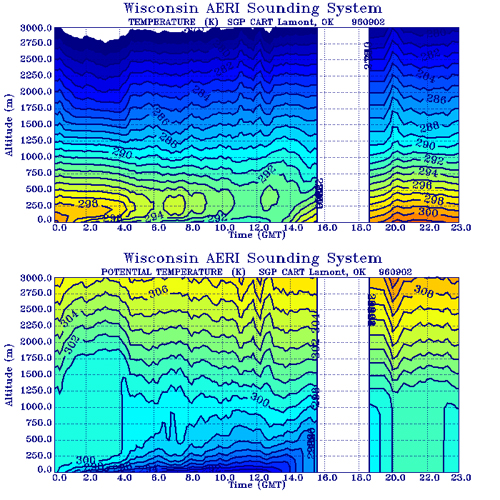WVIOP 96: Water Vapor Intensive Observation Period (WVIOP 96)
A series of water vapor intensive observation periods (WVIOPs) were conducted at the Atmospheric Radiation Measurement (ARM) site in Oklahoma between 1996 and 2000. The goals of these WVIOPs are to characterize the accuracy of the operational water vapor observations and to develop techniques to improve the accuracy of these measurements.
Dr. Henry E. Revercomb, Space Science and Engineering Center, University of Wisconsin-Madison
The primary goal of these IOPs is to optimize the capabilities of CART instrumentation for characterizing atmospheric water vapor. While the first IOP concentrated on the lowest kilometer of the atmosphere for satisfying the identified needs of the IRF group, the second IOP will concentrate more on the upper troposphere, as small errors at this altitude has a large effect on the net radiation escaping to space. Also, differences with altitude were seen between two Raman lidars (the CART and NASA/GSFC), as well as radiosonde systematic errors, at these higher altitudes. Another important goal is to address the issue of absolute calibration. There are several independent methods which could be used as the absolute calibration reference, the chilled mirrors, DIAL lidar, and GPS to name a few, and careful intercomparisons of these must be done.
Wayne Feltz, Cooperative Institute for Meteorological Satellite Studies (CIMSS), University of Wisconsin-Madison
Investigators
- Dr. Henry E. Revercomb Space Science and Engineering Center (SSEC)
- David D. Turner Space Science and Engineering Center (SSEC)
- David C. Tobin Space Science and Engineering Center (SSEC)
- Robert O. Knuteson Space Science and Engineering Center (SSEC)
- Wayne F. Feltz Space Science and Engineering Center (SSEC)
Related Websites
Publications
-
Porch, W.; Balsley, B.; Cole, H.; Jensen, M.; Lesht, B.; Liljegren, J.; Richardson, S., and Revercomb, H. Application of tethered balloon and kite measurements using chilled mirror hygrometers during the ARM WVIOP in the fall of 1996 in Oklahoma. Symposium on Meteorological Observations and Instrumentation, 10th, Phoenix, AZ, 11-16 January 1998 (preprints). Boston, MA, American Meteorological Society, 1998, pp10-15. Reprint #2610.
-
Revercomb, H. E.; Turner, D. D.; Tobin, D. C.; Knuteson, R. O.; Feltz, W. F.; Barnard, J.; Bosenberg, j.; Clough, S.; Cook, D.; Ferrare, R.; Goldsmith, J.; Gutman, S.; Halthorne, R.; Lesht, B.; Liljegen J.; Linne, H.; Michalsky, J.; Morris, V.; Porch, W.; Richardson, S.; Schmid, B.; Splitt, M.; Van Hove, T.; Westwater, E., and Whiteman, D. The ARM Program’s water vapor intensive observation periods: Overview, initial accomplishments, and future challenges. Bulletin of the American Meteorological Society v.84, no.2, 2003, pp217-236. Reprint #3315.
-
Richardson, Scott J.; Tobin, David, and Splitt, Michael E. In situ moisture measurements at the SGP ARM CART CF during the first and second water vapor intensive observation periods. IGARSS ’98: 1998 International Geoscience and Remote Sensing Symposium, Sensing and Managing the Environment, Seattle, WA, 6-10 July 1998. Proceedings, v.4. Piscataway, NJ, Institute of Electrical and Electronic Engineers, Inc. (IEEE), 1998, pp2163-2165. Reprint #2923.
-
Turner, D. D. and Goldsmith, J. E. M. Twenty-four -hour Raman lidar water vapor measurements during the Atmospheric Radiation Measurement Program’s 1996 and 1997 water vapor intensive observation period. Journal of Atmospheric and Oceanic Technology v.16, no.8, 1999, pp1062-1076. Reprint #5484.

